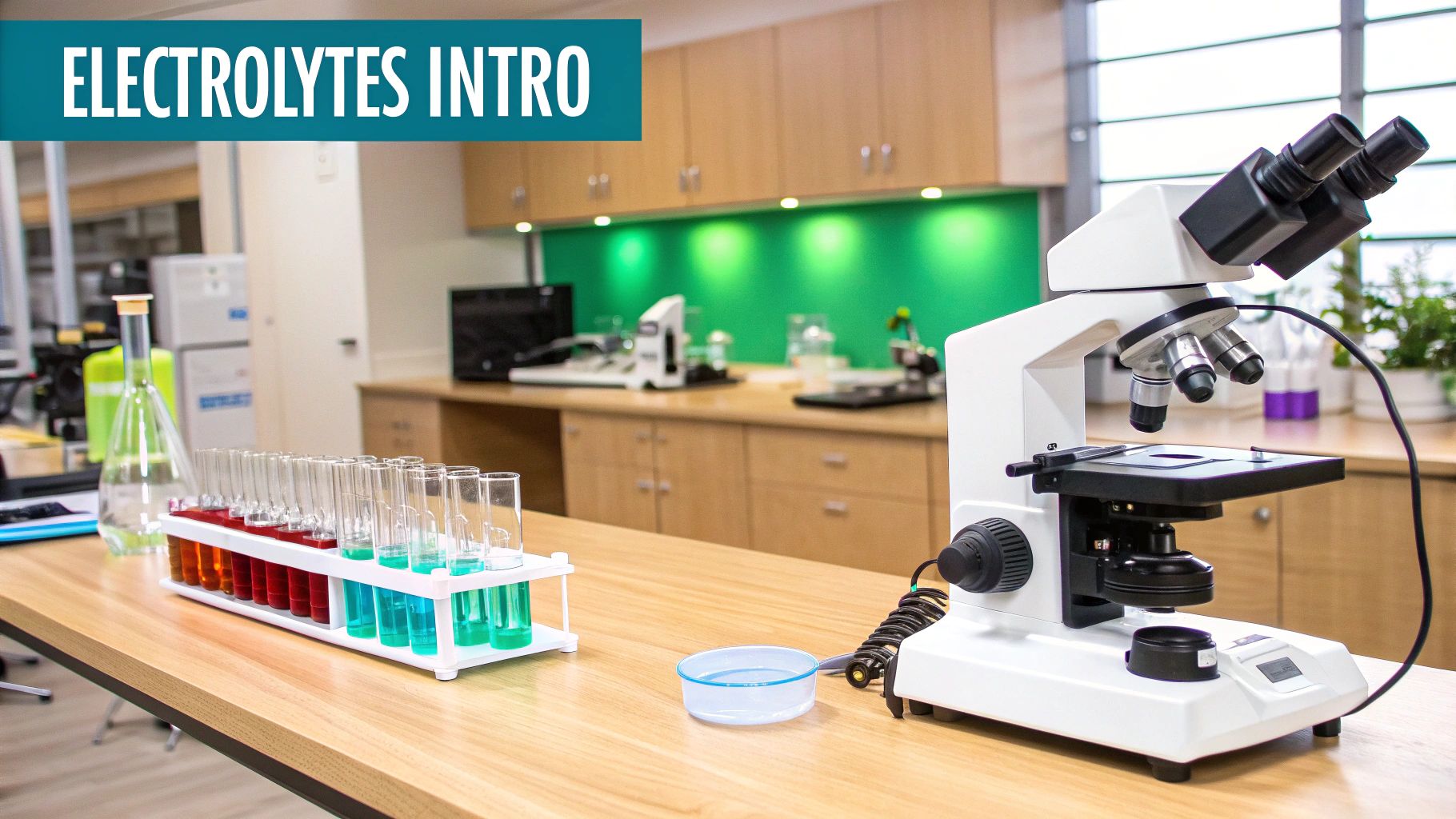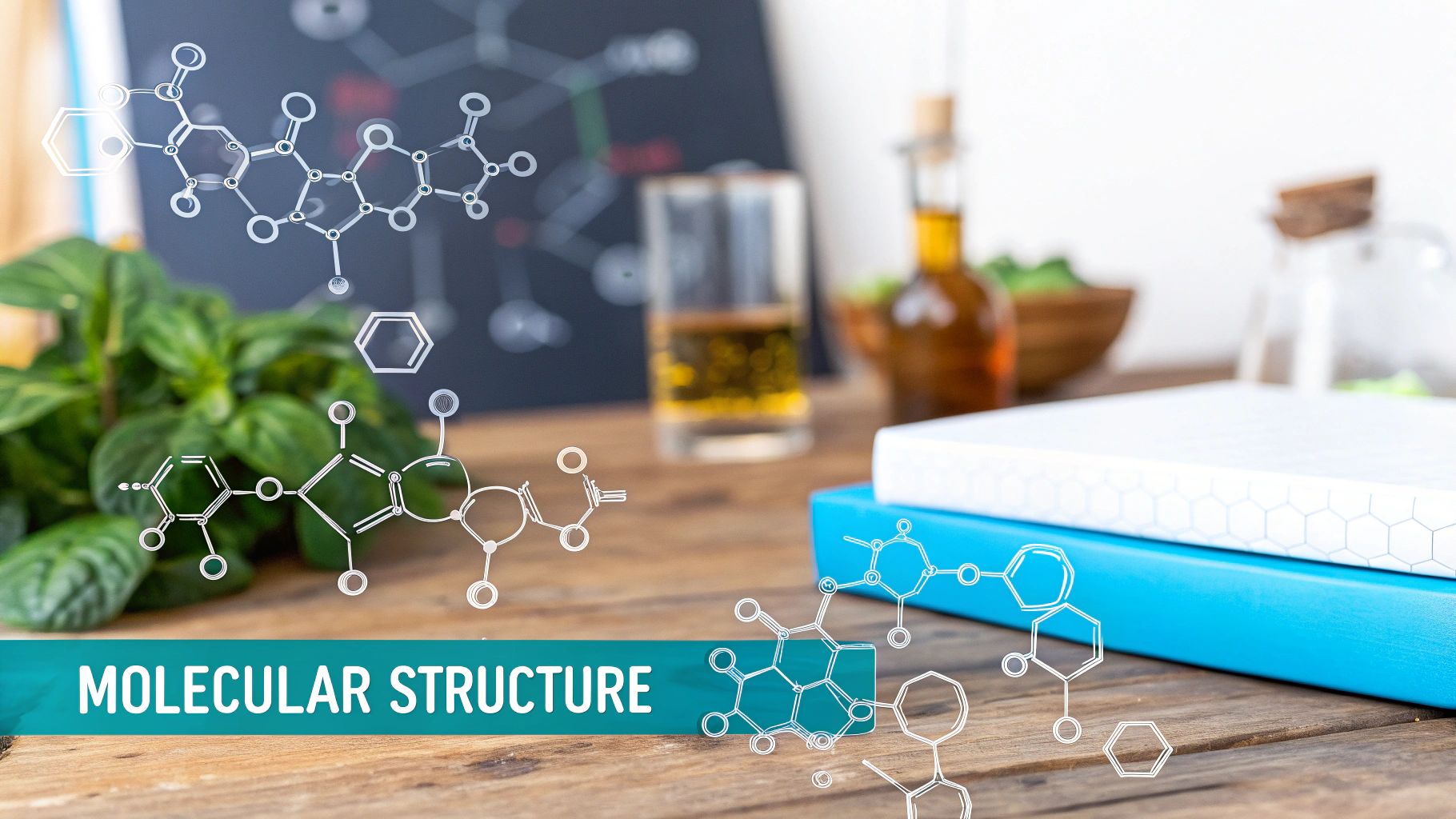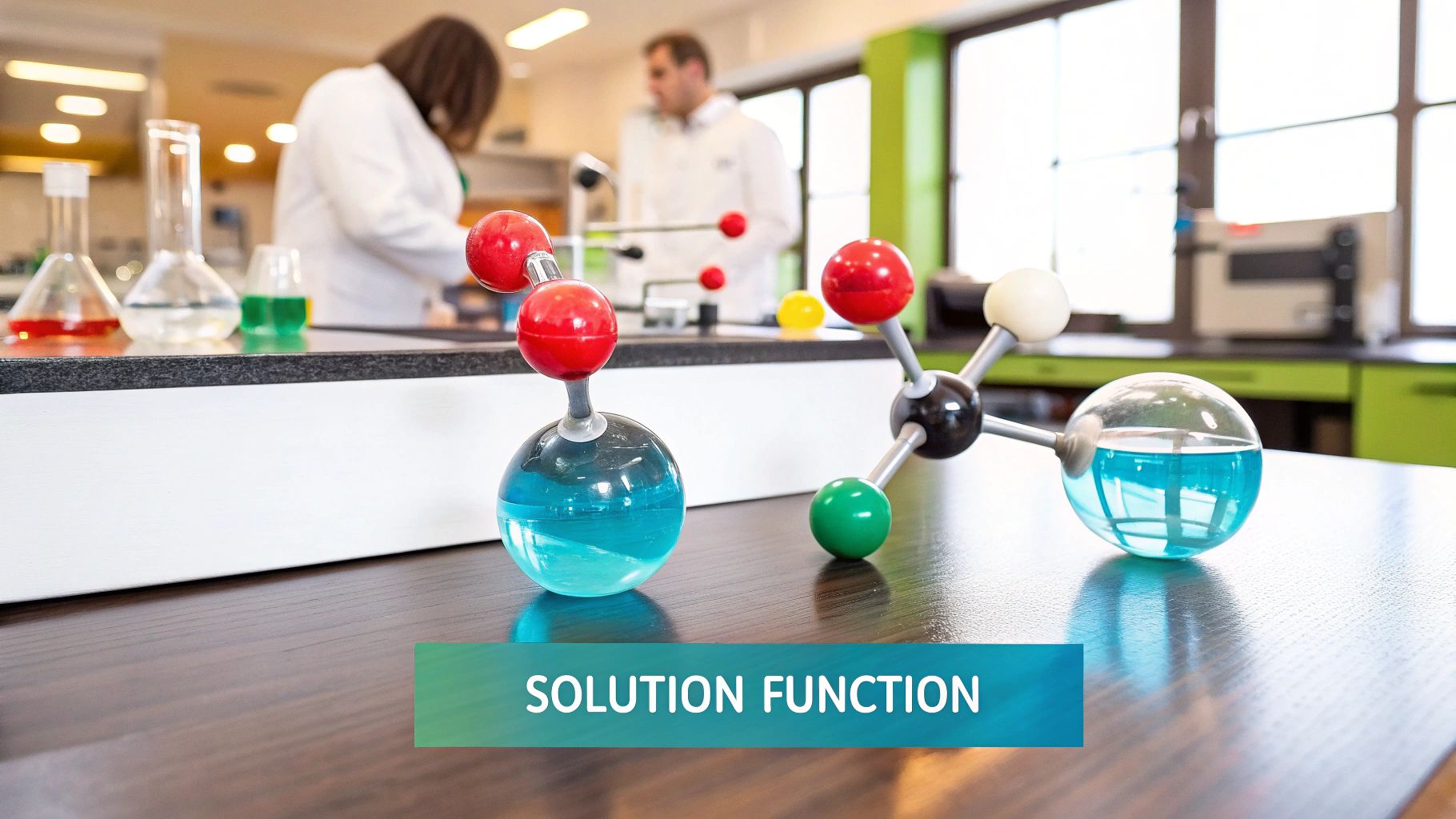

· By Annemarie
What Are Electrolytes and Nonelectrolytes: Explained
The Fascinating World of Electrolytes: Beyond the Basics

Electrolytes are essential for various bodily functions. But what exactly are they, and why are they so important? This fascinating branch of chemistry affects everything from how our cells operate to the performance of our cars. Electrolytes are substances that conduct electricity when dissolved in water.
This ability comes from their capacity to break down into charged particles called ions. This process is crucial for biological systems, industrial processes, and even environmental events. Familiar examples of electrolytes include salts, acids, and bases.
These substances dissolve in water, either completely or partially, forming ions. For instance, table salt (sodium chloride) is a strong electrolyte. It dissolves completely into Na+ and Cl– ions, resulting in high conductivity. Electrolytes are fundamental to many aspects of our world.
Diving Deeper into Electrolyte Strength
Not all electrolytes conduct electricity with the same efficiency. This difference leads to the classification of strong and weak electrolytes. Strong electrolytes, as mentioned earlier, dissociate fully in solution.
This complete dissociation means almost every molecule breaks down into its constituent ions. The solution becomes filled with charged particles ready to carry an electrical current. This explains why solutions of strong electrolytes, like saltwater, are excellent conductors.
In contrast, weak electrolytes, such as vinegar (acetic acid), only partially dissociate. In these solutions, many molecules remain whole, reducing the number of free ions available to conduct electricity. This results in lower conductivity compared to strong electrolyte solutions. You can explore more in our blog articles.
Concentration's Impact on Conductivity
The concentration of electrolytes significantly impacts conductivity. A higher concentration means more ions are present in the solution. This increased ion presence boosts the solution's ability to conduct electricity.
Imagine adding more lanes to a highway. More cars (ions) can travel at the same time, leading to faster traffic flow (greater conductivity). This principle underlies the formulation of sports drinks.
These drinks contain electrolytes at specific concentrations to effectively replace those lost through sweat during exercise. This concept also applies to batteries, where the precise concentration of electrolytes is critical for proper function.
Electrolytes in Action: Real-World Examples
Electrolytes aren't limited to laboratories. They're everywhere! From sports drinks replenishing lost ions after exercise to the batteries powering our devices, electrolytes are constantly at work.
Even Earth’s oceans, with their high concentration of dissolved salts, demonstrate the conductivity of electrolytes on a massive scale. This prevalence highlights the broad impact of these essential substances.
Nonelectrolytes: The Silent Partners in Chemical Solutions

While electrolytes often steal the spotlight, their counterparts, nonelectrolytes, play equally vital roles in various chemical solutions. These essential substances might not conduct electricity, but their presence is critical across diverse applications, from the food we eat to the medications we take. This exploration delves into the world of nonelectrolytes, examining their properties and emphasizing their significance.
Understanding Nonelectrolyte Behavior
Unlike electrolytes, nonelectrolytes do not break down into ions when dissolved in water. This means no charged particles are produced in the solution, preventing electrical conductivity. Common examples include glucose (the sugar fueling our bodies), ethanol (found in alcoholic beverages), and urea (a waste product in urine).
These substances dissolve easily in water, creating homogenous mixtures while retaining their molecular structure. This characteristic is key to their unique properties and broad range of uses. The non-conductive nature of these solutions, for example, is critical in specific industrial processes and medical treatments.
Historically, the study of nonelectrolyte solutions began with Johannes van der Waals in 1873. He sought to understand the thermodynamic behavior of these mixtures. Unlike electrolytes, nonelectrolytes, such as glucose, urea, and ethanol, remain as whole molecules in solution. This molecular integrity impacts physical properties like vapor pressure, boiling point, and osmotic pressure differently than in ionic solutions. Learn more about nonelectrolytes here.
The Importance of Nonelectrolytes in Various Applications
The unique properties of nonelectrolytes make them essential across diverse fields. In the pharmaceutical industry, they serve as solvents and stabilizers in drug formulations. The non-reactive nature of many nonelectrolytes makes them ideal for delivering medications without affecting their effectiveness.
Food production also heavily relies on nonelectrolytes. Sugars, for instance, act as preservatives, sweeteners, and texture modifiers in various food products. Their presence contributes significantly to the taste, consistency, and shelf life of many foods we consume daily.
Furthermore, several nonelectrolytes are crucial for industrial processes. They function as coolants, lubricants, and cleaning agents, often chosen for their non-conductive characteristics. In situations where electrical conductivity is undesirable, nonelectrolytes offer a safer alternative to their ionic counterparts.
Benefits of Using Nonelectrolytes
The distinct characteristics of nonelectrolytes offer several advantages. Their non-corrosive nature, due to the lack of free ions, promotes safer use in many environments. This is especially valuable when working with delicate materials or equipment.
Additionally, their ability to dissolve other substances without changing their chemical properties is highly beneficial. This makes them suitable for applications like drug delivery, where maintaining the active ingredient's integrity is paramount. Finally, the controlled physical properties they exhibit, such as their impact on boiling and freezing points, allow for precise control in industrial and manufacturing processes.
How We Discovered Electrolytes: Scientific Breakthroughs

Our understanding of electrolytes and nonelectrolytes has a rich history. It's a fascinating story of scientific curiosity and persistent investigation. Early observations about the behavior of different solutions led to groundbreaking discoveries that transformed our understanding of chemistry.
Early Observations and the Puzzle of Conductivity
Early chemists observed a curious difference between solutions. Some could conduct electricity, while others couldn't. This puzzling observation sparked a quest to uncover the underlying mechanisms. What made certain dissolved substances facilitate the flow of electrical current? The answers, it turned out, were hidden within the very nature of the dissolved substances themselves. Scientists began a series of experiments to unlock the secrets of this electrical conductivity.
Svante Arrhenius and the Ionic Dissociation Theory
A major breakthrough occurred in the 1880s thanks to the work of Swedish chemist Svante Arrhenius. He proposed the ionic dissociation theory. This radical idea suggested that certain substances, like salts, dissociate into charged particles called ions when dissolved in water. Initially, this theory was met with considerable resistance. It challenged the then-current understanding that ions only formed during electrolysis. Despite the controversy, Arrhenius’s theory was eventually validated, earning him the Nobel Prize in Chemistry in 1903. This prestigious award solidified his contribution to our understanding of electrolytes. In 1884, Arrhenius significantly advanced our understanding of electrolytes by proposing that salts, when dissolved in water, break down into these charged particles. This groundbreaking idea was later confirmed through experiments focusing on electrical conductivity and colligative properties. Discover more insights about electrolytes.
Confirming the Theory: Experiments with Conductivity and Freezing Points
Experimental evidence soon supported Arrhenius's theory. Scientists measured the electrical conductivity of various solutions. They discovered a clear correlation between the conductivity and the concentration of dissolved electrolytes. This provided strong support for the presence of ions in solution. Further validation came from studying colligative properties, like freezing-point depression. These studies showed that electrolyte solutions had lower freezing points than nonelectrolyte solutions at the same concentration. This occurs because the dissolved electrolyte breaks into multiple ions, increasing the total number of particles in the solution, which in turn lowers the freezing point.
From Theory to Application: The Impact of Understanding Electrolytes
Understanding electrolytes has significantly impacted numerous fields. From developing life-saving medical treatments to designing efficient batteries, the principles discovered by Arrhenius and his contemporaries continue to shape our world. These principles are fundamental to many applications, including the creation of sports drinks. This understanding allows manufacturers to carefully control electrolyte concentrations, like those in Upside Hangover Sticks. This helps replenish electrolytes lost during physical activity. The ability to measure and control solution conductivity has also enabled advancements in various areas, from medical diagnostics to industrial processes and environmental monitoring.
Electrolytes vs. Nonelectrolytes: What Really Sets Them Apart

Understanding the differences between electrolytes and nonelectrolytes is crucial. These differences affect everything from basic chemical reactions to the complex processes that keep our bodies functioning. Let's dive into a comparison that will clarify these vital substances.
Electrical Conductivity: The Defining Difference
The most significant difference lies in their ability to conduct electricity. Electrolytes conduct electricity when dissolved in water. This is because they dissociate into ions, or charged particles, which allow the solution to carry an electric current. Nonelectrolytes, on the other hand, don't dissociate into ions. Therefore, their solutions do not conduct electricity. This fundamental difference is key to understanding their various uses.
Effect on Colligative Properties
Another key difference is how they affect colligative properties. These properties, such as freezing point depression and boiling point elevation, depend solely on the number of solute particles in a solution, not their identity. Electrolytes break down into multiple ions, having a larger effect on these properties. For example, salt water freezes at a lower temperature than sugar water of the same concentration. This occurs because the salt dissociates into ions, increasing the total number of solute particles. This principle also explains why electrolyte solutions are so important for hydration, a benefit offered by products like Upside Hangover Sticks.
Molecular Behavior in Solution
Electrolytes and nonelectrolytes also behave differently at the molecular level. Electrolytes dissociate into their constituent ions, which are then surrounded by water molecules in a process known as hydration. Nonelectrolytes, however, remain as intact molecules dispersed in the water. They experience weaker intermolecular forces. This structural difference is crucial for understanding their distinct chemical and physical properties.
To help visualize these differences, let's look at the following table:
Electrolytes vs. Nonelectrolytes: The Complete Picture This table provides a side-by-side comparison of the key properties and behaviors of electrolytes and nonelectrolytes, highlighting their fundamental differences.
| Property | Electrolytes | Nonelectrolytes |
|---|---|---|
| Electrical Conductivity | Conducts electricity | Does not conduct electricity |
| Dissociation | Dissociates into ions in solution | Remains as intact molecules in solution |
| Effect on Colligative Properties | Greater effect due to ion dissociation | Lesser effect |
| Examples | Salts, acids, bases | Sugar, alcohol, urea |
As this table summarizes, the core differences between electrolytes and nonelectrolytes impact their roles in various situations.
Real-World Implications: From Osmosis to Industrial Applications
These differences have a significant impact on various applications. The varying effects on osmosis, vital for cellular function, highlight the role of electrolytes in biological systems. In industrial settings, the conductivity of electrolytes is crucial for processes like electroplating. The non-conductive nature of nonelectrolytes is equally important in other applications.
The Life-Sustaining Power of Electrolytes in Your Body
Our bodies depend on a precise balance of electrolytes. These electrically charged minerals, like sodium, potassium, and calcium, are fundamental for life itself. They're not just terms you hear in science class; they power everything from the beating of your heart to the way you stay hydrated. Let's explore just how vital these electrolytes are.
The Role of Electrolytes: From Heartbeats to Hydration
Electrolytes are the quiet workhorses behind many bodily functions. For example, sodium is essential for fluid balance, regulating the water content inside and outside your cells. This has a direct impact on your hydration levels.
Potassium, on the other hand, is crucial for nerve signal transmission and muscle function. It's the communication link between your brain and muscles, enabling movement.
And calcium? It’s not just about strong bones. Calcium also contributes to muscle contraction and nerve function. A balanced calcium level is essential for a steady heartbeat.
Maintaining this delicate balance is key for optimal health.
To illustrate the importance of precise electrolyte regulation, consider that human plasma typically contains about 135-145 millimoles per liter (mmol/L) of sodium and 3.5-5.0 mmol/L of potassium.
The following table provides a deeper look at some essential electrolytes and their functions in the human body:
Essential Electrolytes in Human Physiology
| Electrolyte | Normal Range | Primary Functions | Imbalance Disorders |
|---|---|---|---|
| Sodium (Na+) | 135-145 mmol/L | Fluid balance, nerve and muscle function | Hyponatremia (low sodium), Hypernatremia (high sodium) |
| Potassium (K+) | 3.5-5.0 mmol/L | Nerve and muscle function, fluid balance | Hypokalemia (low potassium), Hyperkalemia (high potassium) |
| Calcium (Ca2+) | 8.5-10.5 mg/dL | Bone health, muscle contraction, nerve function | Hypocalcemia (low calcium), Hypercalcemia (high calcium) |
| Chloride (Cl-) | 95-105 mmol/L | Fluid balance, nerve function | Hypochloremia (low chloride), Hyperchloremia (high chloride) |
| Magnesium (Mg2+) | 1.5-2.5 mg/dL | Muscle and nerve function, blood sugar control | Hypomagnesemia (low magnesium), Hypermagnesemia (high magnesium) |
This table highlights the crucial roles electrolytes play and the potential health consequences of imbalances. Maintaining appropriate levels of these electrolytes is clearly essential for overall well-being. For more information on electrolytes and their importance, check out this resource: Electrolytes.
Recognizing and Addressing Electrolyte Imbalances
While our bodies work hard to maintain balance, electrolyte imbalances can still occur. Hyponatremia (low sodium) can result from excessive sweating, certain medications, or underlying medical conditions. Symptoms may include headaches, confusion, and muscle weakness.
Hyperkalemia (high potassium), can be caused by kidney problems or certain medications. This can lead to irregular heartbeats and muscle fatigue.
Fortunately, we can prevent and treat these imbalances. Staying hydrated, especially during exercise, is crucial. Eating electrolyte-rich foods, like bananas, oranges, and spinach, is also beneficial. In some cases, electrolyte supplements or medical intervention may be necessary.
Electrolytes and Exercise: Fueling Your Performance
Electrolytes are especially important during exercise. Sweating depletes essential electrolytes, particularly sodium and potassium. This loss can impair muscle function and cause fatigue. Replenishing electrolytes is therefore vital for anyone who exercises regularly, especially in hot and humid conditions.
Many sports drinks offer electrolyte replenishment, but choose carefully. Some are high in sugar and artificial ingredients. Upside Hangover Sticks offer a convenient and effective way to support electrolyte balance. Their unique jelly format and natural ingredients make them a healthier option for maintaining optimal performance and recovery.
Practical Tips for Electrolyte Management
Here are some practical tips for managing your electrolyte levels:
- Hydrate regularly: Drink plenty of water throughout the day, especially before, during, and after exercise.
- Eat electrolyte-rich foods: Include fruits, vegetables, and dairy products in your diet.
- Consider electrolyte supplements: Consult your doctor about whether supplements are right for you, particularly if you exercise intensely or have underlying health conditions.
- Choose healthy sports drinks: Select low-sugar options with natural ingredients.
- Listen to your body: Pay attention to symptoms of electrolyte imbalance, such as muscle cramps, fatigue, or headaches.
Understanding how electrolytes function and how to manage their levels empowers you to make informed decisions for a healthier, more energetic life.
Powering Innovation: Real-World Applications That Matter
The difference between electrolytes and nonelectrolytes goes beyond textbook chemistry. These compounds are essential to a wide range of industries, powering technologies we rely on daily, from the batteries in our smartphones to advanced medical treatments.
Electrolytes: The Driving Force Behind Essential Technologies
Electrolyte solutions are key to electroplating, a process used to create durable and corrosion-resistant finishes. From jewelry to car parts, electroplating relies on the conductivity of electrolytes to deposit a thin layer of metal onto a surface, improving both appearance and lifespan. Electrolytes are also fundamental to modern battery technology. Whether it's the lithium-ion battery in your phone or the lead-acid battery in your car, the movement of ions within an electrolyte solution allows these devices to store and release energy. Common electrolytes used in batteries include salts like sodium chloride (NaCl) or potassium hydroxide (KOH).
Nonelectrolytes: Essential Components in Medicine and Beyond
Nonelectrolytes, while not electrically conductive, are equally important. Frequently used in pharmaceutical formulations, their non-reactive nature allows them to dissolve and deliver medications without affecting their efficacy. Many liquid medications, for example, utilize nonelectrolytes like glucose or sucrose to create syrups or suspensions. Nonelectrolytes also find use in various industrial processes, serving as coolants, lubricants, and cleaning agents. Their non-corrosive properties make them a safe and effective choice in many applications. Electrolytes are also important for muscle function and physical activity; you might want to explore different workout routines.
Emerging Technologies: Pushing the Boundaries of Electrolyte Science
Beyond established uses, research continues to explore new applications for electrolytes and nonelectrolytes. In renewable energy, scientists are developing advanced electrolyte materials for next-generation batteries and fuel cells, striving for greater energy storage and efficiency. Similarly, in environmental remediation, specialized electrolyte solutions are being used to remove pollutants from contaminated water and soil. Learn more about electrolytes and nonelectrolytes by checking out this resource.
The Future of Electrolytes and Nonelectrolytes
The future of electrolytes and nonelectrolytes holds immense promise. As materials science and chemical engineering advance, these substances will likely play a central role in addressing global challenges and shaping future technologies. From sustainable energy solutions to medical advancements, the unique properties of electrolytes and nonelectrolytes offer tremendous potential.
Ready to experience the benefits of a balanced electrolyte system? Try Upside Hangover Sticks! These convenient jelly sticks offer a quick and effective way to replenish essential electrolytes after a night out. Visit Upside to learn more and place your order.
